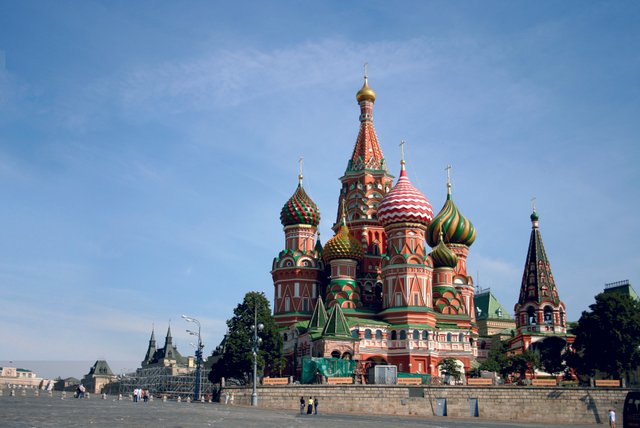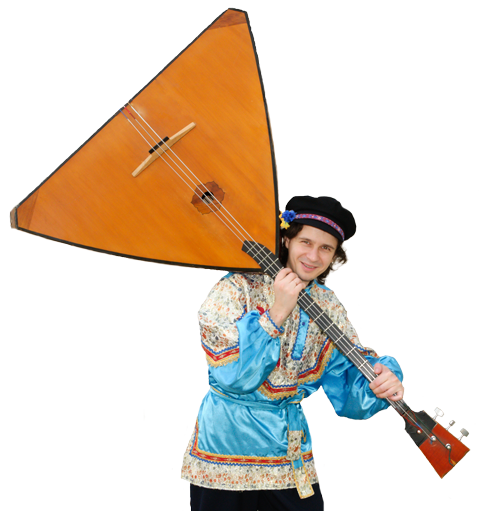WORLD MUSIC TRADITIONS - Russia & The Balalaika
Russia is the largest country on the planet. While more than 80 percent of its territory is in Asia, it is European Russia, the part west of the Ural Mountains, that represents Russia’s political and cultural identity to the outside world. The two largest cities, Moscow and St. Petersburg, are the destinations for most tourists, who discover a unique juxtaposition of the architecture of Czarist Russia, with its pastel-colored Baroque-like palaces and onion-domed Russian Orthodox churches, and Soviet Russia (1917–1991), which exchanged color for monumental concrete buildings and statues of steel. Since the dissolution of the Soviet Union in 1991, Russia, still a world power, has striven to transform itself from a totalitarian communist regime to a democratic free market society. This transition has not been easy, but the Russian people are resilient, having dealt with many dramatic political changes in their history.

During the nineteenth and twentieth centuries, Russian nationalism inspired much artistic development, especially in music. Many Russian “art music” composers, such as Nikolai Rimsky-Korsakov (1844–1908), Pyotr Ilich Tchaikovsky (1840–1893), and Igor Stravinsky (1882–1971), are counted among the greatest composers of the last two centuries. While many urbanites of modern Russia would rather consider these composers and their music as the essence of Russian musical identity, the work songs, chastushki (playful songs), and dance tunes of the Russian countryside inspired many of the most revered Russian composers and are in fact more indicative of Russia’s distinctive musical culture.
The Balalaika
The “chattering,” high-pitched sound of the prima balalaika is apparent even in a full balalaika orchestra, as is heard in our example. This music may remind you of a German Oktoberfest as it has a “polka” feel, but it is distinctly Russian. Though the instrumentation is certainly different, such dance genres are also a staple of Russian folk music.

As is typical of musical performance in Europe, harmony is the key musical element. In this case, the major instrument heard is the balalaika, the most popular folk instrument in Russia. The balalaika’s most distinctive feature is its triangular-shaped resonating body. The instrument can be found in varying sizes, but the most common type is the prima balalaika, which has a wooden sound box a little more than 1 foot (30 cen- timeters) long on each side and a fretted neck that extends the instrument to nearly 3 feet (91 cm). Most balalaika have just three strings. Two strings are tuned to the same pitch or an octave apart, while the third string is tuned to a fourth above the root. The strings are usually made of steel, nylon, or gut and are played with the fingers, though sometimes a leather plectrum may be used.
The balalaika was most commonly used as a courting instrument, but also was found among court musicians. Its popularity waned during the early nineteenth century with the introduction of the harmonica, until its cause was picked up by a Russian nobleman, Vasily Vasilyevich Andreyev (1861–1918), who is today nicknamed the “Father of the Balalaika.”
Andreyev first became intrigued by the instrument after hearing one of his workers play it. In the spirit of Russian nationalism, he promoted the balalaika as the distinctive musical instrument of Russia and succeeded in modernizing the instrument so that it could play a classical repertoire. Andreyev had five different-sized balalaika created, the largest being the size of a double bass. His ensemble had its debut in 1888 to great acclaim and by 1892 had won the support of the Russian royalty. Afterward his Russian Balalaika Orchestra toured Europe and even visited America.
As is typical of European folk music, the melody is relatively short and repetitive. The double bass balalaika plods along with the basic harmonic structure as smaller-sized balalaika and domra “chatter” out the melody. An accordion helps to fill in the harmony and adds another timbre to the overall sound. Of note is the near absence of “percussion” instruments other than the occasional rattling of a tambourine.Double Bass Balalaika:

Though polyphonic vocal ensembles are more characteristic of Russian folk music, the balalaika has become the distinctive visual symbol of Russian musical identity. The predecessor of the balalaika is a similar lute, known as a domra, which has a round resonator. The earliest records of the domra date to the seventeenth century. The primary performers on the instrument were wandering minstrels and jugglers who performed for weddings, festivals, and other celebratory activities. These entertainers, known as skomorokhi (“jesters”), commonly appeared in costume, dressed up as, for example, an animal or a witch, in order to attract an audience.
Unfortunately, the ruling powers of the time issued decrees that put strict restraints on various peasant activities, including the performance of music. In 1648 the czar ordered that all music instruments be burned and decreed that anyone who dared to play music would be flogged and exiled to the outer reaches of the kingdom. The balalaika likely developed as a consequence: because it was easier to make a triangular-shaped body than a round one, it could be more quickly made if a musician had been forced to abandon his original instrument for fear of persecution. After the harassment of Russian musicians subsided in the eighteenth century, the instrument became quite popular for its distinctive look and charac- teristic “chatter-like” sound. The balalaika’s name is derived from the Russian word meaning “to chat,” and its sound is intended to contrast with the violin, which is considered to “sing.”
Andreyev encouraged the dissemination of the balalaika among the populace by teaching soldiers and common folk to play the instruments, often giving them free instruments. Under Soviet rule, the balalaika continued to play a vital role in promoting Russian nation- alism, and by the end of the twentieth century, it had regained its prominence as the most popular instrument in the country. Today it is frequently sought after by tourists and is used by balalaika “combos,” which are popular in major cities throughout Europe.

🎶🎵Sharing my music all around the world! 🎵🎶
Spotify
Facebook
Steemit
Instagram
Would love to visit Moscow someday and see that famous cathedral.
Yeah same here! and play some music around hahaha :)
Nice article!
Thank you :)
Hi, @nadabrahmasounds!
You just got a 0.77% upvote from SteemPlus!
To get higher upvotes, earn more SteemPlus Points (SPP). On your Steemit wallet, check your SPP balance and click on "How to earn SPP?" to find out all the ways to earn.
If you're not using SteemPlus yet, please check our last posts in here to see the many ways in which SteemPlus can improve your Steem experience on Steemit and Busy.
Congratulations @nadabrahmasounds! You have completed the following achievement on the Steem blockchain and have been rewarded with new badge(s) :
Click here to view your Board of Honor
If you no longer want to receive notifications, reply to this comment with the word
STOPDo not miss the last post from @steemitboard: